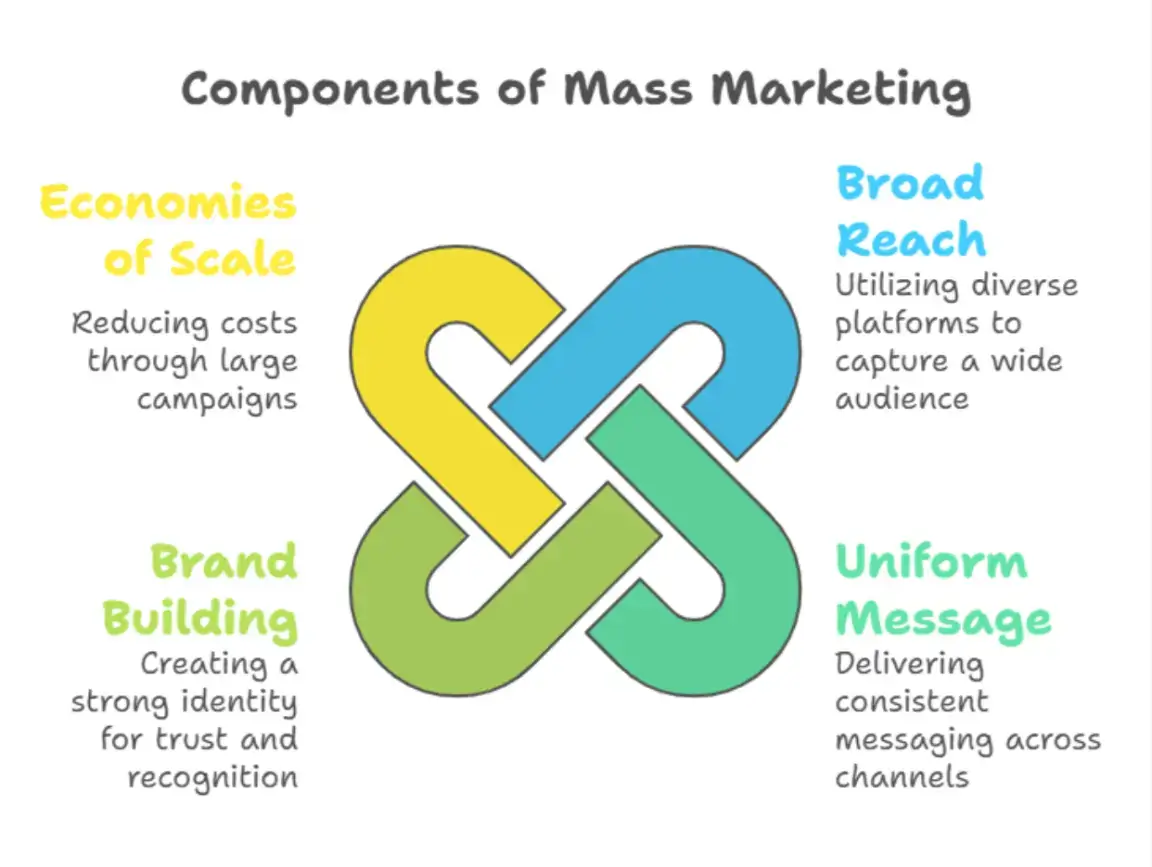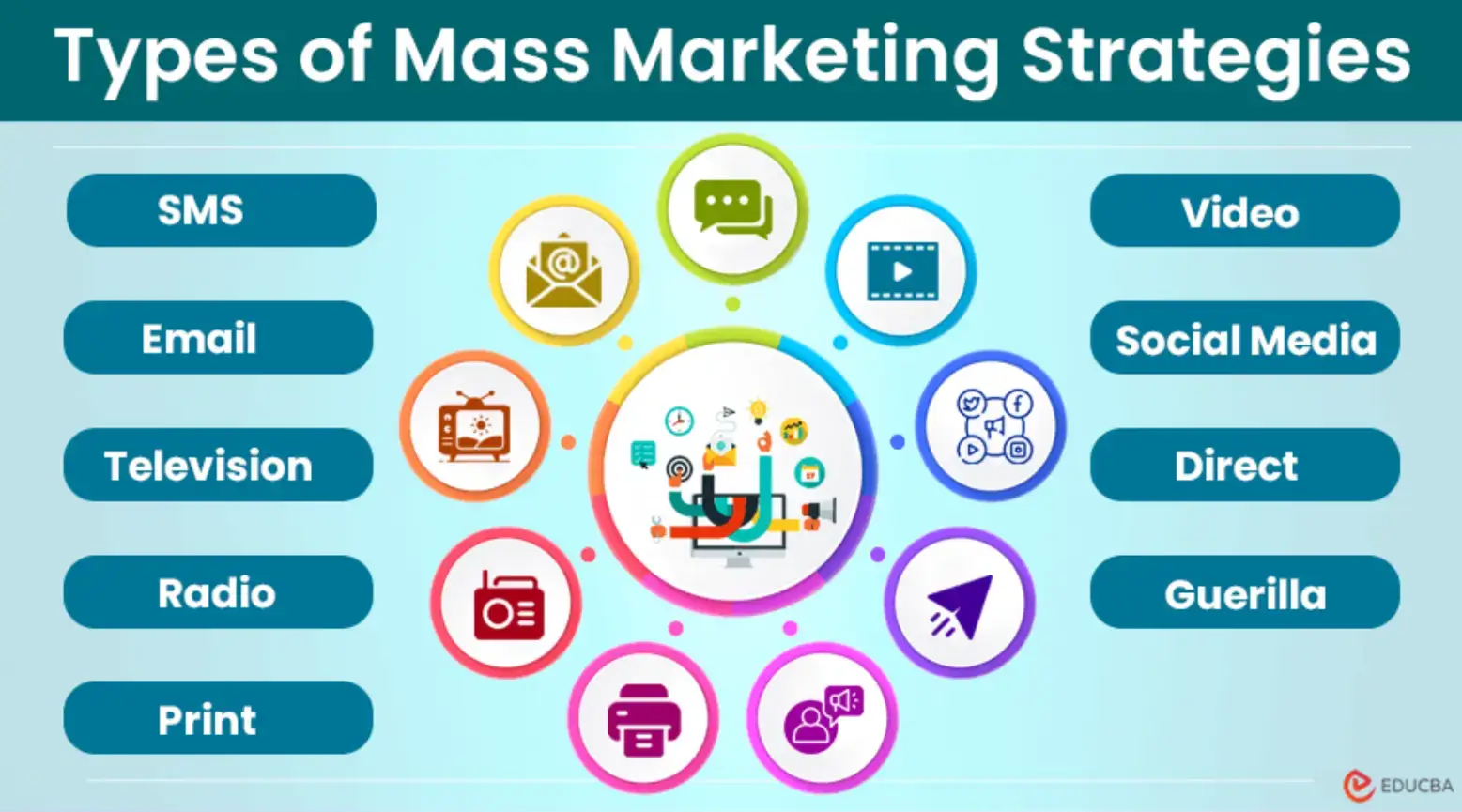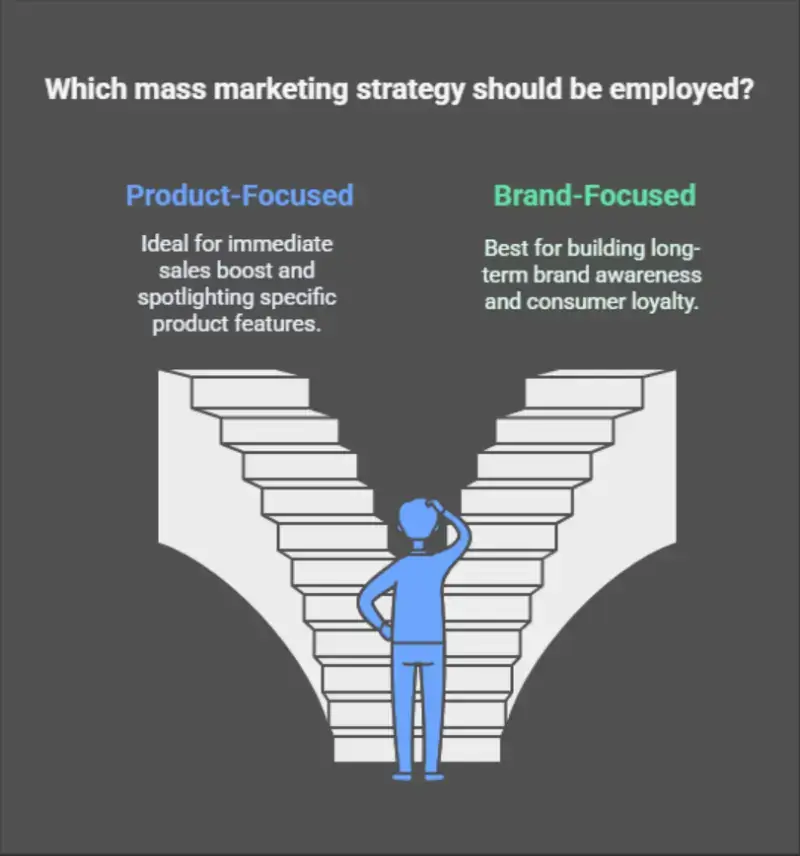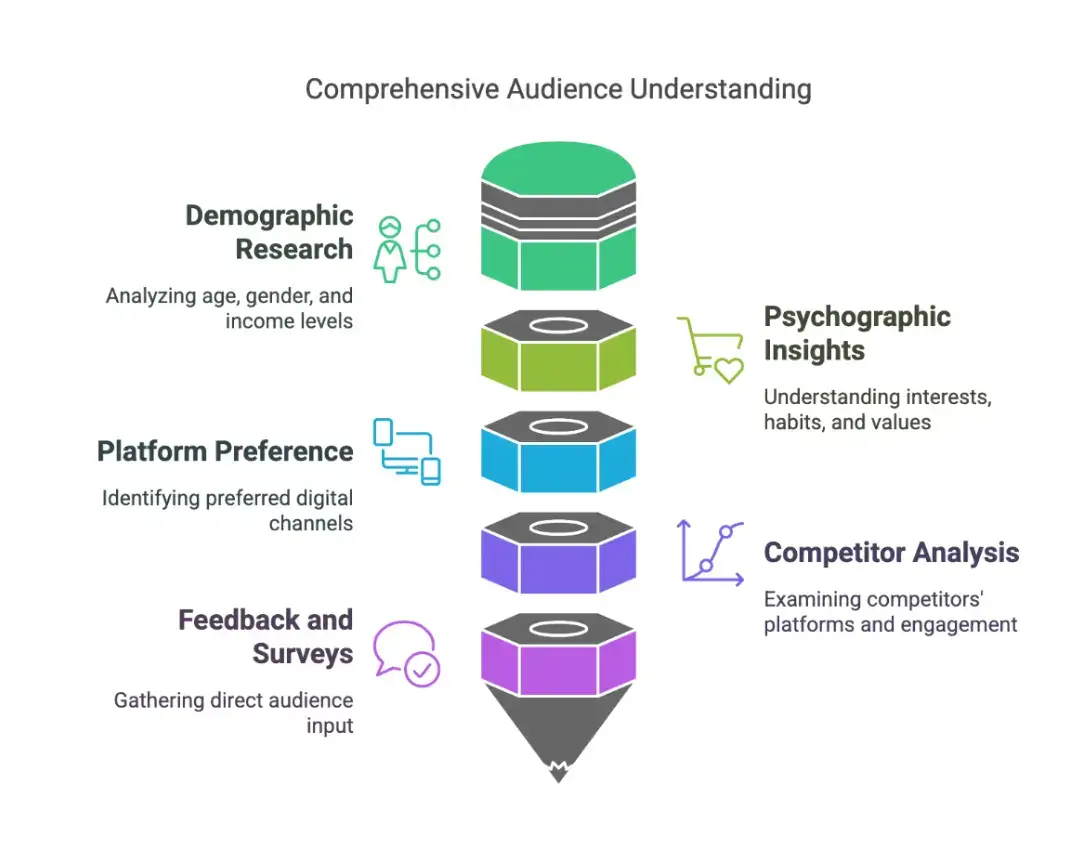Have you ever wondered why some marketing campaigns seem to reach everyone yet leave you indifferent?
This phenomenon is called mass marketing, and it's a fascinating beast—one that has shaped everything from global advertising strategies to the way brands position themselves in crowded marketplaces.
Imagine launching a campaign that seamlessly taps into a broad audience, almost whispering secrets to the wind.
Sounds like magic, right? In many ways, it is. Mass marketing carries a certain mystique because when it’s executed well, it feels effortless, natural, and universal.
My experience in marketing leadership positions at consulting companies like Volkswagen and BMW has shown me that mastery of mass marketing techniques is not only a theory but also an essential part of modern business.
When you’re steering campaigns reaching millions, understanding how to craft messages for the many—not the few—becomes a powerful skill.
The digital promotional landscape remains influenced by this controversial approach, which requires marketing initiatives to be identical, scalable, and broadly appealing. Even as personalization becomes popular, the core principles of mass marketing still drive huge brand successes.
In this article:
- What is Mass Marketing?
- Definition of Mass Marketing
- Key Characteristics of Mass Marketing
- How Mass Marketing Works
- When Mass Marketing Makes Sense
- Types of Mass Marketing Campaigns
- Single-Channel Mass Marketing
- Multichannel Mass Marketing
- Product-Focus vs. Brand-Focused Mass Marketing
- Examples of Mass Marketing
- Mass Marketing vs. Niche Marketing (Simple Comparison)
- How to Improve a Mass Marketing Campaign
- Audience Research is Essential
- Personalization is Key
- Measure Performance
- When Should Businesses Use Mass Marketing?
- Mass Marketing in the Digital Era
- Statistics That Show Why Mass Marketing Still Matters
Emerging businesses that use mass marketing achieve revenue growth of 10% greater than other companies in their industry.
Even with the rise of niche targeting, statistical evidence shows that a well-executed mass marketing plan can produce outcomes that cannot be ignored.
This platform caters to both beginners who want to explore mass media potential and professionals who need advanced mass-marketing strategies.
Whether you're launching your first campaign or optimizing an established one, the principles discussed here can strengthen your ability to communicate at scale.
Drawing from my experience helping more than 500 businesses—large and small—this article explores the foundational mechanisms of mass marketing. It illustrates why its influence remains strong even in a hyper-personalized era.
So, ready to explore the intricacies of mass marketing? Your next big idea might be a billboard away.

Source: Freepik
What is Mass Marketing?
Imagine sending a marketing message so loud and clear that it echoes through every corner of the world. That’s the essence of mass marketing: communication at scale, crafted to resonate with a broad public.
Sounds thrilling, right? That’s because mass marketing, at its core, relies on the power of mass media trends to reach massive audiences with synchronized, compelling advertising messages.
In today’s diverse world, even modern tools like Facebook lead ads do not replace mass marketing—they expand its possibilities, adding precision without eliminating universality.
Definition of Mass Marketing
Mass marketing is a strategy where businesses promote a product or service to the widest possible audience using a single, standardized message.
The goal is to reach millions of consumers at once through high-reach channels like TV, radio, print, and digital display ads.
Because the target market is broad and undifferentiated, mass marketing emphasizes volume, brand recognition, and consistency rather than personalization.
Where targeted marketing says, “Speak differently to each group,” mass marketing says, “Find the one message that speaks to everyone.”
Companies like AUDI AG and Volkswagen AG have used wide-reaching campaigns for decades, reinforcing brand presence through sweeping initiatives and broad distribution display ads.
But mass marketing is not limited to TV commercials or highway billboards. In practice, it includes:
- large-scale search campaigns
- big-budget social pushes
- universal messaging in brand storytelling
- high-frequency digital display campaigns
Integrating traditional approaches with modern strategies—such as Instagram marketing—can exponentially expand reach. Digital channels have transformed mass marketing from a one-directional broadcast into a multi-touch ecosystem.
Another often overlooked aspect: Understanding niche markets can strengthen your mass campaigns. Insights gained from smaller segments often scale beautifully when applied with broad appeal.
Key Characteristics of Mass Marketing
Mass marketing operates on a grand scale, aiming to generate awareness across a wide and varied audience.
What differentiates mass marketing from other strategies is its reliance on mass media channels, which can deliver a single message consistently to millions.
Television, radio, newspapers, billboards, and online platforms all function as megaphones—amplifying a brand’s message to the general population.
Large-scale enterprises often value mass marketing because it aligns with their macro objectives, such as building long-term brand dominance or maintaining a strong public presence. Companies like Volkswagen and Audi have benefited from consistency and scale for decades.
But smaller businesses can also leverage mass marketing principles. When combined with targeted digital tactics—like B2C email marketing—mass marketing becomes even more effective.

Here are five defining characteristics of mass marketing:
- Broad Audience Reach: Messaging is designed to appeal to the general population.
- Standardized Products: Same offer, same branding, same messaging everywhere.
- High-Volume Advertising: Use of national TV, radio, billboards, and mass digital placements.
- Economies of Scale: Lower per-customer cost due to high production and distribution volume.
- Brand Building Focus: Campaigns aim to create widespread awareness rather than niche conversion.
If I could pinpoint a distinct advantage of mass marketing, it would be its ability to generate rapid awareness across extensive demographics without needing intricate segmentation strategies.
How can businesses effectively strategize such campaigns? By brainstorming innovative ideas, staying current with consumer behavior shifts, and adapting messaging without losing consistency.
How Mass Marketing Works
- Develop a universal message that resonates with the majority of consumers.
- Choose high-reach media channels (TV, radio, outdoor ads, national publications).
- Distribute the same message everywhere to ensure consistency across markets through repeated exposure.
- Drive brand recognition through repeated exposure across the market.
- Measure performance using reach, impressions, recall, and sales lift—not niche engagement metrics.
When Mass Marketing Makes Sense
Mass marketing isn’t the right strategy for every business, but it works well when:
- Your product has universal appeal
(e.g., beverages, household goods, streaming services) - You want to increase brand awareness quickly
- You need to reach as many people as possible
- Your product doesn’t require detailed education or comparison
- You have a broad target audience rather than niche customers
Types of Mass Marketing Campaigns

Source: EDUCBA
Ever wonder how some brands seem to appear everywhere at once—on your social feeds, on billboards during your commute, in commercials, and even in unexpected places like product placements in TV shows?
That’s the power of a carefully designed mass marketing campaign.
Mass marketing isn’t chaotic scattering—it’s a well-planned effort to connect with audiences from multiple angles. Understanding the types of campaigns available helps businesses choose the strategies that best support their goals.
Let’s break down the most common approaches.
Single-Channel Mass Marketing
As the name suggests, single-channel mass marketing relies on one primary communication platform to reach a broad audience. This can be a TV network, a radio station, a publication, or a digital channel, such as a podcast or blog.
Why would a business focus on just one platform?
Because sometimes, a highly targeted and influential channel can deliver massive reach on its own.
Imagine launching an innovative tech gadget and choosing a top tech podcast as your primary platform. If that podcast has a loyal audience of millions, you can generate significant exposure using that one channel alone.
During my work with various companies, I often relied on a single platform that closely aligned with a target demographic. When your message resonates deeply within a single medium, engagement rises naturally.
To address more complex challenges, I often recommend studying the channel’s audience. Are they tech enthusiasts? Busy professionals? Students? Their identity shapes how your message should be crafted.
Modern enhancements like AI live chat tools can elevate single-channel strategies by enabling businesses to answer inquiries in real-time, making the customer experience feel more cohesive and personalized.
In many cases, being selective with channels yields powerful results.
Mass marketing isn’t always about using every platform; sometimes, it’s about maximizing the platform that matters most.
Multichannel Mass Marketing
From my years in marketing, I’ve seen multichannel mass marketing transform brand visibility more dramatically than almost any other strategy.
If single-channel is a megaphone, multichannel is a symphony—multiple instruments creating one unified message.
This approach casts a wide net across various mass media platforms:
- TV
- radio
- billboards
- print magazines
- public transit ads
- digital display networks
- social media
The goal is repetition and reinforcement. When consumers encounter your brand across multiple contexts, it becomes memorable—even inevitable.
Using tools like AI forecasting can help businesses determine which channels are most effective and how to allocate budgets efficiently.
Feeling overwhelmed by the idea of coordinating across so many platforms? You’re not alone.
Repeated exposure fosters strong brand awareness—a fundamental outcome of successful mass marketing.
Research is essential. Determine where your audience spends time, whether on social platforms, streaming services, or traditional media like TV and magazines.
And don’t shy away from innovation. Incorporating emerging tools like AI-driven analytics can refine your strategy and differentiate your brand.
Multichannel marketing isn’t just a trend—it’s necessary in today’s hyper-competitive landscape. Brands that embrace diverse media channels typically see higher visibility and stronger long-term growth.
Product-Focused vs. Brand-Focused Mass Marketing

When guiding companies through mass marketing strategies, one of the most important decisions is choosing between a product-focused or brand-focused campaign. Both approaches have unique benefits and demand clarity of purpose.
A product-focused campaign highlights a specific product or feature. It’s ideal when businesses want to drive immediate sales or draw attention to a new release.
For instance, auto brands like BMW and Audi often spotlight new model features across their advertising channels to build immediate buzz.
Many businesses choose a product-focused approach when they need measurable outcomes quickly—like boosting sales during a seasonal promotion or promoting a limited-time offer.
On the other hand, brand-focused campaigns aim to build long-term recognition and loyalty. They don’t focus on one product but on the essence of the brand itself. Think of iconic jingles, memorable slogans, or visual identities that stay with you for years.
During my tenure at Audi and Volkswagen, many campaigns concentrated on reinforcing brand identity across a diverse, global audience.
Brand-focused strategies foster an emotional connection, which often leads to long-lasting customer loyalty.
So, which should your business choose?
It depends on your objectives. If you’re launching a specific product and want immediate traction, a product-focused campaign works best.
But if you want to elevate your company's long-term visibility and emotional resonance, invest in brand-focused marketing.
In many cases, the most successful strategies use both approaches at different times. Mastering this balance can lead to deeply impactful campaigns that build both recognition and revenue.
Success doesn’t hinge solely on visibility or frequency—it depends on the emotional connection you create.
Campaigns that leverage powerful narrative elements, such as storytelling techniques, often leave lasting impressions that transcend individual advertisements.
Examples of Mass Marketing
Mass marketing is a strategy I have used across various industries throughout my career, and it remains one of the most versatile approaches for reaching broad audiences. Its principles can be applied to countless sectors—from retail to entertainment to hospitality—and its effectiveness often lies in its simplicity.
This approach is widely used in industries such as eCommerce and restaurants, where the goal is to appeal to the general public rather than a narrowly defined segment.
Think about a bustling neighborhood grocery store—its customers span every age, background, and lifestyle. Mass marketing mirrors this diversity, embracing a wide audience rather than focusing on a niche.
Few things exemplify mass marketing better than TV commercials. These ads broadcast to millions simultaneously, creating shared moments of consumer engagement.
Whether it’s a memorable Super Bowl commercial or a routine ad during a popular show, TV spots epitomize broad-reach, mass-consumption content.
Consider watching a major sporting event: You’ll often notice the same advertisements repeating, from car insurance to fast food to beverage brands.
These advertising messages are carefully designed to appeal to a widespread audience and make an impression that withstands repetition.

Source: Viindoo
Digital channels have expanded mass marketing’s reach even further. Tools like email marketing software for events help organizers contact thousands—or even millions—of people at once.
Beyond distributing promotional materials, organizers can recognize participants with certificates created through an AI certificate maker, adding personalized touches at scale.
Whether you're promoting a concert, conference, or corporate seminar, these platforms enable businesses to deliver personalized yet widespread outreach.
That combination—broad reach with a human feel—is part of what makes modern mass marketing so powerful.
In my work with companies like Volkswagen and Bayer, the goal was rarely to “serve an ad.” The true objective was to make the brand resonate with millions.
Mass marketing doesn’t merely broadcast information; it shapes perception and cultural relevance.
Similarly, direct mail campaigns—which some believe are outdated—still prove surprisingly effective.
Physical mail creates a tangible connection that digital channels sometimes lack, and when executed at scale, it becomes an influential mass marketing tool.
Who would have predicted that in the digital era, print mailers would still contribute significantly to engagement? Yet, they do.
From hair salons to large home improvement services, examples offer insight into how businesses can broaden their visibility.
Traditional methods still hold value, but combining them with innovative digital tools strengthens campaigns tremendously.
To truly succeed, businesses must embrace both mediums—legacy mass strategies and modern digital solutions—to ensure their message reaches the heart of the mass market.
A few more examples of mass marketing include:
- Coca-Cola: Universal “open happiness” branding that appeals to all ages and cultures.
- McDonald’s: Standardized global menu advertising with the same slogans and visuals.
- Nike: Broad brand messaging like “Just Do It” targeting everyone from casual runners to pro athletes.
- Colgate & Dove: FMCG brands that run national TV commercials promoting essential, everyday products.
- Apple iPhone Launch Ads: High-budget campaigns aimed at general consumers, not segmented audiences.
Mass Marketing vs. Niche Marketing (Simple Comparison)
| Feature | Mass Marketing | Niche Marketing |
|---|---|---|
| Audience Size | Very broad | Small, specific segment |
| Message | Universal, standardized | Tailored and personalized |
| Cost Structure | High upfront costs | Lower overall cost |
| Product Type | General-use products | Specialized or premium |
| Goal | Brand awareness & mass adoption | High engagement & loyalty |
How to Improve a Mass Marketing Campaign
Ever felt like your marketing efforts vanished into thin air? You’re not alone—and fortunately, there’s a solution.
Mass marketing isn’t merely about broadcasting a message widely; it’s about crafting a story compelling enough that everyone can see themselves in it, regardless of demographic differences.
Think of mass marketing not as shouting into a void but as stepping onto a large stage. The question is: will your spotlight fade into a dull background, or will it illuminate something unforgettable?
Improving mass marketing campaigns requires more than luck. It demands thoughtful planning, strategic awareness, and the willingness to adapt.
Every business—whether a startup or a global giant—can elevate its mass marketing efforts with the right approach.
Let’s dive into key strategies that consistently enhance results.
Audience Research is Essential
Understanding your target audience is the cornerstone of any high-performing mass marketing campaign. While mass marketing aims for broad appeal, that doesn’t eliminate the need for audience insight—in fact, the opposite is true.
To craft a message that resonates widely, you must first understand the underlying patterns across diverse groups.
How do you speak to millions while still sounding relatable?
It begins with research.
Over the years, I’ve learned that in-depth audience research not only informs creative development but also determines which platforms are most effective.
Demographics, psychographics, and geography all play vital roles in shaping the tone and delivery of your messaging.
Think of this research as your campaign’s compass. It points you toward opportunities, prevents misalignment, and ensures your message resonates across a wide population.
Don’t wait until your strategy feels polished. Begin with the insights you have now, launch quickly, and let data guide your iterations.
Here are the main types of research that strengthen mass marketing campaigns:
- Demographic Research: Explore age, gender, income, education, and family structure to identify universal themes your campaign can tap into.
- Psychographic Insights: Examine values, lifestyle, interests, motivations, and buying habits to uncover emotional triggers that appeal broadly.
- Platform Preference: Understand which digital channels your audience frequents—social media, search engines, mobile apps, streaming platforms—to ensure you meet them where they are.
- Competitor Analysis: Study competing campaigns and the engagement they generate. Tools like content management platforms can help you analyze what resonates.
- Feedback and Surveys: Collect direct input to understand pain points, expectations, and common desires across your audience.

One key takeaway from my experience is that audience research is never a “one-and-done” task. It’s ongoing. Every interaction—every click, email, conversation, and comment—creates an opportunity to refine your message.
Start where you are. Use what you have. Iterate continuously.
These principles ensure your mass marketing messages rise above the noise and make meaningful contact with a broad audience.
Personalization is Key
When diving into mass marketing, personalization might sound counterintuitive. Isn’t the entire point to reach everyone?
Yes—but reaching everyone doesn’t mean speaking generically.
In fact, the most effective mass marketing campaigns include personal touchpoints that make broad audiences feel individually recognized.
Personalization doesn’t mean endlessly segmenting; it means identifying shared values, aspirations, or frustrations that resonate across groups—and highlighting them clearly.
Personalization within mass marketing can also include:
- speaking in an authentic, relatable tone
- weaving universal emotions into messaging
- building campaigns around shared cultural moments
- using accessible language that feels conversational rather than corporate
- incorporating interactive elements like quizzes or polls
- leveraging customer data to refine universal themes rather than tailor individual frameworks
Today's consumers crave relevance. Even when a campaign targets millions, people want to feel like the message considers their needs, experiences, or desires.
The beauty of mass marketing lies in its ability to connect with countless individuals through a single cohesive message—one that feels personal, even when it’s crafted for the world.
Measure Performance
Even the most creative mass marketing campaign needs measurable outcomes to determine whether your message is truly resonating.
Without clear metrics, it’s impossible to know which elements are working, which need refinement, and where to focus future investments.
Mass marketing often spans multiple platforms, so performance tracking should be equally comprehensive. The goal is to identify patterns—both expected and unexpected—that reveal how audiences respond across different touchpoints.
Here are key performance indicators (KPIs) worth monitoring:
- Reach & Impressions: How many people saw your campaign? High reach is often the baseline indicator of mass-marketing success.
- Engagement Rates: Interactions like clicks, comments, shares, and video completions indicate whether your message is compelling.
- Brand Recall Surveys: Measuring how well audiences remember your message or brand after exposure gives insight into long-term impact.
- Conversion Lift: Even if mass marketing isn’t hyper-targeted, it should still influence customer actions. Monitor changes in sales, sign-ups, or inquiries.
- Channel Effectiveness: Evaluate which platforms deliver the best returns. You may discover that traditional channels outperform digital—or vice versa.
- Cost Efficiency: Track metrics like CPM (cost per thousand impressions) to ensure large-scale campaigns remain financially sustainable.
I always recommend establishing a performance dashboard before launching. Real-time analytics enable course correction while a campaign is live, giving you the agility to fine-tune messaging, shift budget, or reallocate reach.
By consistently measuring performance, your mass marketing strategy evolves from guesswork into a data-driven engine for growth.
When Should Businesses Use Mass Marketing?
Mass marketing is ideal when:
- Your product appeals to a very wide audience (e.g., beverages, fast food, essential goods).
- You aim to build brand awareness quickly.
- Your business benefits from economies of scale.
- Personalization is not required for purchasing decisions.
- You’re launching a new product category and need mass recognition.
Mass Marketing in the Digital Era
Mass marketing has evolved beyond TV and print. Today, brands use:
- YouTube ads to reach millions with short, broad-appeal videos.
- Programmatic display campaigns targeting massive online audiences.
- Social media broad-reach campaigns (Facebook and TikTok “Reach” objectives).
- Streaming TV and digital radio to replicate traditional mass-media reach at a lower cost.
Digital platforms now allow mass marketing at a fraction of old media costs, making it accessible even to small businesses.
Statistics That Show Why Mass Marketing Still Matters
- TV still reaches over 70% of adults weekly (Nielsen).
- Global mass-media ad spend exceeds $300 billion per year (Statista).
- Super Bowl commercials reach over 115 million viewers, making it the largest mass-marketing event annually.
- Brands using broad-reach advertising see up to 2× higher increases in brand recall compared to narrow-targeting strategies (Kantar).
Frequently Asked Questions
What is mass marketing in simple terms?
It’s a strategy where businesses promote one message to a large, general audience without segmenting consumers.
What is an example of mass marketing?
Brands like Coca-Cola and McDonald’s use mass marketing to reach millions with the same message worldwide.
Is mass marketing still effective today?
Yes—digital channels like YouTube, streaming TV, and social ads allow broad reach at lower costs.
What is the difference between mass marketing and niche marketing?
Mass marketing targets everyone; niche marketing targets a small, defined consumer group.
What types of products are best for mass marketing?
Everyday consumer goods, fast food, beverages, personal care products, and mass-appeal technology devices.
Conclusion
Mass marketing may seem like a broad and sometimes unpredictable discipline, but its power lies in its simplicity: one cohesive message delivered to many.
When supported by strong research, consistent creative execution, measured performance, and a touch of personalization, mass marketing becomes more than just advertising—it becomes a unifying brand experience.
Whether you're promoting a product, strengthening a brand, or expanding into new markets, mass marketing ensures your message reaches audiences far beyond the confines of segmentation. And in an increasingly fragmented world, that kind of reach is invaluable.
Master the fundamentals, refine them through data, and remain open to evolving channels. When executed with intention, mass marketing doesn’t just amplify your voice—it turns it into something unforgettable.


